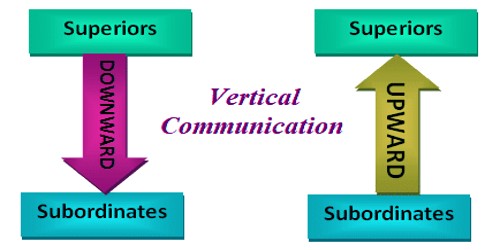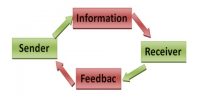Advantages of Vertical Communication
Vertical communication occurs when information flows in a vertical direction i.e. up to down and down to up within an organization. Thus, upward and downward communication together makes vertical communication. The merits or reasons for vertical communication are mentioned below:
- Bringing the people into the communication network:
Vertical communication brings all the people working at various levels of an organization within the scope of communication. Both downward and upward communications are allowed in vertical communication which ensures proper feedback. Instructions or directions for the appropriate execution of official functions can be transmitted through this communication.
- Informing organizational goals and plans:
Vertical communication is the means of informing organizational goals, plans, programs, policies, etc. to the subordinates. Through this communication system, upper-level management can send the policies and procedures to the subordinates.
- Communicating directives of superiors:
It also helps in communicating and implementing orders, instructions and advice of the superiors. Duties and responsibilities can be delegated among departments thorough vertical communication.
- Conveying the message of subordinates:
Through the upward direction of vertical communication channels, subordinates can convey their suggestions, complaints, recommendations, and opinions to their superiors. As it follows the formal media it has documentary evidence which can be used in the future.
- Motivating the subordinates:
Through a downward pattern of vertical communication, the superiors can motivate their subordinates.
- Maintaining the chain of command:
Established chain of command can be easily maintained through vertical communication. People at levels of the organization somehow come within the scope of vertical communication and communicate among them by following an established chain of command. Under this communication system superior and subordinates barter message straight. So there is no chance to by-passing. So, a sense of discipline may be developed among the employees.
- Assigning jobs and evaluates performance:
Vertical communication facilitates job assignment and job evaluation in the most befitting manner. Through downward communication, supervisor assign jobs to their subordinates and subordinates convey their feedback so their superiors through upward communication. Vertical communication is one of the recognized media of internal communication.
- Identifying de problems of subordinates:
The upward pattern of vertical communication help to know the employees’ attitudes and to identify their problems. In vertical communication official channels are used thus strict discipline can be maintained.
- Creating a better relationship:
The free and fair flow of information in vertical communication improves relationships between management and workers. There is an organized flow of information under his communication system, so a good relationship can be developed between superiors and subordinates.
- Increase efficiency and Coordinating the efforts:
Vertical communication facilitates bringing the efforts of all participant of an organization into a uniform line. Essential instructions are sent to subordinates and they execute their duties and tasks consequently that is a help to increase effectiveness both superior and subordinate. As a result, an organization can attain its goals.
- Effective decision making:
Superiors needed a variety of information to take assessment making in the organization. With the help of vertical communications, superiors accumulate information form subordinate. Information transmitted through vertical communication is authentic and dependable.
















